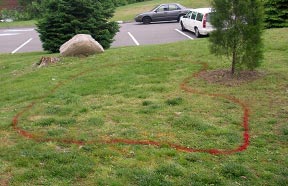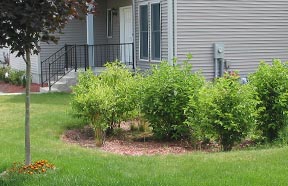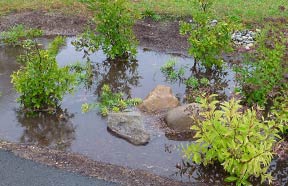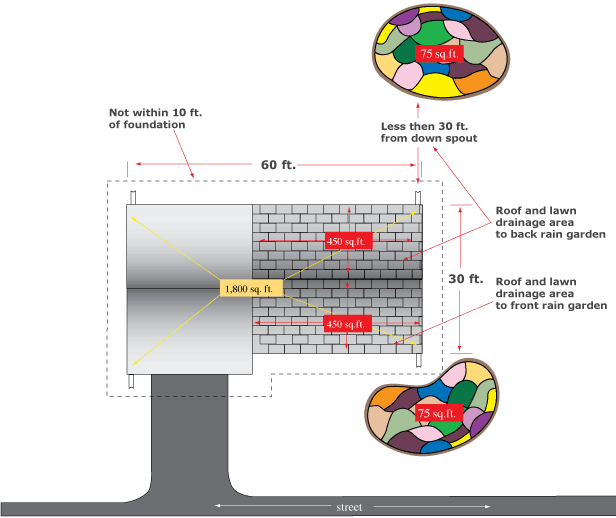Picking a Site
Planning for your rain garden is an important step and should not be overlooked. Not every location in your yard is ideal for installing a rain garden. For most residential settings, you will be trying to capture runoff from your house roof and directing it to your rain garden. This can be accomplished by piping the downspout directly into your garden, or by letting it run over grass before entering the garden. Here are several points to consider when choosing the site in your yard:
- Avoid placing the rain garden in a low spot in the yard that always seems wet. A rain garden is not a water garden or a wetland. Placing it in poorly drained soils may lead to slow infiltration and unwanted long term ponding.
- Keep your rain garden at least 10 feet away from your house if you have a basement. Infiltrating water close to your foundation can lead to water problems in the basement.
- Do not install the rain garden over your septic system, or close to your drinking water well.
- Do not install a rain garden in an area where bedrock or stone outcrops are closer than 2 feet to the surface.
- Avoid steep slopes. Rain gardens can be installed using a retaining wall design on moderate slopes, but the construction of this type of garden is more complicated. Rain gardens are easiest to install in flat or slightly sloped areas.
- Plan for overflow from the garden. Although your garden will be sized to contain the most frequent storms, it will likely not contain the increased volumes of water from larger storms. This is OK, but you will need to be aware of where the water will go if it overflows from the garden. In most cases this will just be on your lawn, but you want to make sure the overflow is not directed towards your foundation.
Where To Put Your Garden Video


For most residential settings, you will be trying to capture runoff from your house roof and directing it to your rain garden.
Checking the Soils
Rain gardens are built to hold water during rain events, however water should infiltrate the ground within 24 hours.
The underlying soils are an important component of your rain garden. To determine if your soils are suitable for a rain garden:
- Determine the soil drainage class at your site using our soil drainage map;
and/or
- Conduct a quick infiltration test:
- Dig a hole 6-8 inches deep in the area where you would like to install the garden.
- Check the level of the water in the hole after 6 hours. If the water is gone, the site is suitable for a rain garden. If the water takes 6-24 hours to disappear, the site is probably OK, but you may need to amend your soils. If the water has still not disappeared after 24 hours, you should find a different site for your garden. For a better percolation test, see the demonstration video below.
- Special note for newly or recently constructed homes: Take note of the soil as you dig your hole. Typically with new construction there is a very thin (2-3 inches deep) layer of topsoil over compacted subsoil. What this means is that you may need to loosen up and/or amend the bottom of your rain garden with compost to provide adequate organic matter and a good growing environment for your plants. This will be addressed further in the installation section.
Testing Your Soil How To Video

For most residential settings, you will be trying to capture runoff from your house roof and directing it to your rain garden.
Sizing Your Rain Garden
Residential rain gardens are often sized to hold one inch of runoff in above-ground storage from the contributing impervious surface. In this area of the country, the majority (around 90%) of storms are one inch or less in size. What this means is that sizing the garden to contain this volume of water will give the most benefit, without oversizing it to try to contain larger, more infrequent events that are a much smaller portion of the total yearly runoff volume.
There are two ways to determine the size of your rain garden:
(ONE) Use our Sizing Map. It's as simple as locating your impervious surface(s) on the aerial map, click around the perimeter and click the "Calculate Area" button. That's it!
(TWO) Use the following steps to measure the size of the area draining to your garden (and see figure below).
- Measure the footprint of your house. This is the area taken up by your house if looking down from above. Multiply the length by the width of the house, the answer will be square feet (or square meters if you are using metric measurements).
- Estimate how much of the area actually drains to the area where you want to install the garden. Typically, gutters drain to both ends of a house, so the length can be cut in half, but this is not always the case.
- If you are collecting runoff from your driveway or a section of road, just estimate the size of the impervious surface draining to the spot where you want to put the garden, and continue to step 4.
- Divide this area by 6. This calculation sizes the garden to hold one inch of runoff from the drainage area, in a garden 6 inches deep. The result is the area in square feet (or square meters) that you need for your rain garden. See the example below.
- You can make the garden and shape you like, as long as it is roughly the size that you calculated above. Ovals or kidney-shaped gardens tend to look nicer than square or rectangular gardens, but it's up to you.
Rain Garden Sizing Video

Diagram above adapted from the University of Wisconsin-Extension, Rain Gardens: A How-to Manual for Homeowners.
For citation purposes: University of Connecticut’s Center for Land Use Education and Research. (December 21, 2021). Siting and Sizing. https://nemo.uconn.edu/raingardens/sizing